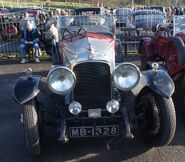
Vauxhall Prince Henry
The Vauxhall Prince Henry was a car manufactured by Vauxhall Motors from 1911 to 1914. It had a length of around 4.05 metres (159.4 in) and a weight of 1,250 kg (2,756 lb) depending on the model and the coachwork fitted.
History[]
Officially classed as the C-10 type, the name "Prince Henry" was introduced to distinguish the three cars that were entered in the 1200 mile (1900 km) long 1910 Motor Trials named in honour of Prince Henry of Prussia. The Vauxhall Prince Henry also competed in other international trials including the 1911 St Petersburg to Sebastopol Trial leading to two cars being sold to Tsar Nicholas II.
The Prince Henry was based on the Vauxhall 20 hp that had been designed in 1909 by then draughtsman Laurence Pomeroy (1883–1941) when the company's chief designer F. W. Hodges was away on holiday. The engine was of 4-cylinder monobloc design with side valves and a capacity of 3054 cc giving 40 bhp (30 kW) output. Three of these cars were entered in the RAC 2,000-mile (3,200 km) trial and one won the speed trials at Brooklands which was part of the event as well as winning the fuel economy award for its class. This victory helped Pomeroy to be promoted to Works Manager. This model was known as the A-Type Vauxhall and was produced, with periodic improvements until 1914, with about 950 being made.
C10-type[]
With the decision to enter the Prince Henry Trial the engine power was increased to 60 bhp (45 kW) at 2800 rpm and as a result of the success replicas were put on the market at £580 and called the C10 type but became better known as the Prince Henry model. In 1913 the engine capacity was increased to 3969 cc and the designation changed to 'C type'. Production continued until 1915.
30/98[]
There was a demand for more power and in 1913 the engine was enlarged again to 4525 cc. Still using the Prince Henry chassis these cars were called the 30/98 it is believed because the car had an output of 30 bhp (22 kW) at 1000 rpm and 98 bhp (73 kW) at 3000 rpm but an alternate explanation is that it had an RAC horsepower rating of 30 and a cylinder bore of 98 mm.
Externally the cars differed from the Prince Henry by having flat rather than V-shaped radiators.
Only 13 30/98s were made before war intervened with several of these going to Australia where one was used by the importer, Boyd Edkins to break the Sydney to Melbourne and Brisbane to Sydney records.
E-type and OE-type[]
Production of the 30/98 restarted in 1919 as the E-type. The engine was carried in a separate subframe on the ladder type chassis with semi-elliptic leaf springs front and rear. The car could be supplied as a chassis for completion by external coachbuilders or with the factory built Velox four-seat open body. 274 were made.
In 1923 the engine was updated and fitted with overhead valves and detachable cylinder head and became the OE-type with a capacity of 4224 cc and power output of 115 bhp (86 kW) at 3300 rpm. From late 1923 front wheel brakes became available, at first cable operated but hydraulic from 1926. 313 were made.
The last cars were made in 1927 and these had a final engine improvement with balanced crankshaft allowing them to be tuned to 120 bhp (89 kW) and a closer ratio gearbox.
D-type[]
From 1912 the D-type was made as a slightly less sporting car with the 3969 cc engine derated to 60 bhp (45 kW). These were made until 1922 with substantial numbers being used as officers' staff cars in World War I. About 4500 were made in total.


